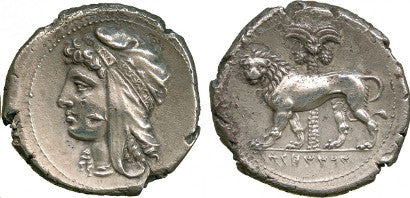A Siculo-Punic silver tetradrachm, circa 360 BC, will lead the New York Sale at Baldwin's on January 7 with a $75,000 estimate.
The coin originates from Sicily, which was invaded by the Carthaginians for a second time in the 3rd century BC, and features a profile of Queen Dido on the obverse with the Carthaginian lion on the reverse.
 The tetradrachm features a profile of Queen Dido, the founder of Carthage |
Dido was the legendary founder of the city of Carthage in around 813 BC, which went on to become one of the most powerful in the ancient world - until its destruction in AD 698.
The coin is considered one of the finest numismatic specimens of the period, with the die engravings most probably created by a local Greek artist.
Only five examples are known to exist, with the other four held in the collections of major museums.
A gold aureus of Rome, featuring a bust of the emperor Geta (AD 209-212), is valued at $50,000.
 There is some controversy among scholars as to whether the figure on the reverse of the coin is Geta or Caracalla |
Geta ruled Rome along with his brother Caracalla for a short period during the second century AD, until his brother had him killed in order to consolidate his own power.
Caracalla made wide-ranging efforts to expunge Geta from the historical records, although his image is preserved on coins of the period - of which this example is among the rarest.
It is in superb condition with a clean strike and a light-toned lustre.
We have a range of rare coins available to purchase.
Click here to sign up to our free newsletter for more on numismatics and other collectibles.






